Great fire of Smyrna
The Catastrophe of Smyrna or the Great fire of smyrna[1][2] (Greek: Καταστροφή της Σμύρνης, "Smyrna Catastrophe"; Turkish: 1922 İzmir Yangını, "1922 Izmir Fire"; Armenian: Զմիւռնիոյ Մեծ Հրդեհ, Zmyuṙno Mets Hrdeh) destroyed much of the port city of Smyrna (modern İzmir, Turkey) in September 1922. Eyewitness reports state that the fire began on 13 September 1922[3] and lasted until it was largely extinguished on 22 September. It began four days after the Turkish military captured the city on 9 September, effectively ending the Greco-Turkish War, more than three years after the landing of Greek army troops at Smyrna on 15 May 1919. Estimated Greek and Armenian deaths resulting from the fire range from 100,000[4][5][6] to 180,000.[7]
| Part of the Greco-Turkish War (1919–22) and Greek genocide | |
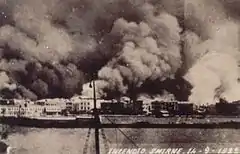 Plumes of smoke rising from Smyrna on 14 September 1922 | |
| Date | 13–22 September 1922 |
|---|---|
| Location | Smyrna (today Izmir, Turkey) |
| Also known as | Great Fire of Smyrna |
| Participants | Turkish Army |
| Outcome | Exodus of the Greek and Armenian population of the city and destruction of their quarters |
| Deaths | 100,000–180,000 (estimate) |

Approximately 80,000[8] to 400,000[9] Greek and Armenian refugees crammed the waterfront to escape from the fire. They were forced to remain there under harsh conditions for nearly two weeks. Turkish troops and irregulars had started committing massacres and atrocities against the Greek and Armenian population in the city before the outbreak of the fire. Many women were raped.[10][11] Hundreds of thousands of Greek and Armenian men (estimates vary between 100,000 and at least 250,000) were subsequently deported into the interior of Anatolia, where most of them died in harsh conditions.[12][13][14]
The fire completely destroyed the Greek and Armenian quarters of the city; the Muslim and Jewish quarters escaped damage.[15] There are different accounts and eyewitness reports about who was responsible for the fire; a number of sources and scholars attribute it to Turkish soldiers setting fire to Greek and Armenian homes and businesses,[16] while pro-Turkish sources hold that the Greeks and Armenians started the fire to tarnish the Turks' reputation.[17] Testimonies from Western eyewitnesses[18] were printed in many Western newspapers.[19][20]
Background
The ratio of Christian population to Muslim population remains a matter of dispute, but the city was a multicultural and cosmopolitan center until September 1922.[21] Different sources claim either Greeks or Turks as constituting the majority in the city. According to Katherine Elizabeth Flemming, in 1919–1922 the Greeks in Smyrna numbered 150,000, forming just under half of the population, outnumbering the Turks by a ratio of two to one.[22] Alongside Turks and Greeks, there were sizeable Armenian, Jewish, and Levantine communities in the city. According to Trudy Ring, before World War I the Greeks alone numbered 130,000 out of a population of 250,000, excluding Armenians and other Christians.[23]
According to the Ottoman census of 1905, there were 100,356 Muslims, 73,636 Orthodox Christians, 11,127 Armenian Christians, and 25,854 others; the updated figures for 1914 gave 111,486 Muslims compared to 87,497 Orthodox Christians.[24]
According to the U.S. Ambassador to the Ottoman Empire at the time, Henry Morgenthau, more than half of Smyrna's population was Greek.[25] The American Consul General in Smyrna at the time, George Horton, wrote that before the fire there were 400,000 people living in the city of Smyrna, of whom 165,000 were Turks, 150,000 were Greeks, 25,000 were Jews, 25,000 were Armenians, and 20,000 were foreigners—10,000 Italians, 3,000 French, 2,000 British, and 300 Americans.[26] Most of the Greeks and Armenians were Christians.[27]
Moreover, according to various scholars, prior to the war, the city was a center of more Greeks than lived in Athens, the capital of Greece.[28][29] The Ottomans of that era referred to the city as Infidel Smyrna (Gavur Izmir) due to the numerous Greeks and the large non-Muslim population.[23][25][30][31][32][33][34][35][36]
Events
Entry of the Turkish Army

As the last Greek troops evacuated Smyrna on the evening of Friday 8 September, the first elements of Mustafa Kemal's forces, a Turkish cavalry squadron, made its way into the city from the northern tip of the quay the following morning, establishing their headquarters at the main government building called Konak.[37][38] Military command was first assumed by Mürsel Pasha and then Nureddin Pasha, General of the Turkish First Army. At the outset, the Turkish occupation of the city was orderly. Though the Armenian and Greek inhabitants viewed their entry with trepidation, they reasoned that the presence of the Allied fleet would discourage any violence against the Christian community. On the morning of 9 September, no fewer than 21 Allied warships lay at anchor in Smyrna's harbor, including the British flagship battleship HMS Iron Duke and her sister King George V, along with their escort of cruisers and destroyers under the command of Admiral Osmond Brock, the American destroyers USS Litchfield, Simpson, and Lawrence (later joined by the Edsall), three French cruisers and two destroyers under the command of Admiral Dumesnil, and an Italian cruiser and destroyer.[39][40] As a precaution, sailors and marines from the Allied fleet were landed ashore to guard their respective diplomatic compounds and institutions with strict orders of maintaining neutrality in the event that violence would break out between the Turks and the Christians.[41]
On 9 September, order and discipline began to break down among the Turkish troops, who began systematically to target the Armenian population, pillaging their shops, looting their homes, separating the men from the women and carrying away and sexually assaulting the latter.[42][43] The Greek Orthodox Metropolitan bishop, Chrysostomos, was tortured and hacked to death by a Turkish mob in full view of French soldiers, who were prevented from intervening by their commanding officer, and much to Admiral Dumesnil's approval.[42][44] Refuge was sought wherever possible, including Paradise, where the American quarter was located, and the European quarters. Some were able to take shelter at the American Collegiate Institute and other institutions, despite strenuous efforts to turn away those seeking help by the Americans and Europeans, who were anxious not to antagonize or harm their relations with the leaders of the Turkish National movement.
Victims of the massacres committed by the Turkish army and irregulars were also foreign citizens. On 9 September, Dutch merchant Oscar de Jongh and his wife were murdered by the Turkish cavalry,[45] while in another incident a retired British doctor was beaten to death in his home, while trying to prevent the rape of a servant girl.[46][47]
Burning
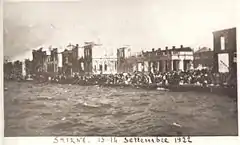
The first fire broke out in the late afternoon of 13 September, four days after the Turkish Army had entered the city.[48] The blaze began in the Armenian quarter of the city (now borough of Basmane), and spread quickly due to the windy weather and the fact that no effort was made to put it out.[49] According to author Giles Milton:
One of the first people to notice the outbreak of fire was Miss Minnie Mills, the director of the American Collegiate Institute for Girls. She had just finished her lunch when she noticed that one of the neighboring buildings was burning. She stood up to have a closer look and was shocked by what she witnessed. "I saw with my own eyes a Turkish officer enter the house with small tins of petroleum or benzine and in a few minutes the house was in flames." She was not the only one at the institute to see the outbreak of fire. "Our teachers and girls saw Turks in regular soldiers' uniforms and in several cases in officers' uniforms, using long sticks with rags at the end which were dipped in a can of liquid and carried into houses which were soon burning.[50]
Others, such as Claflin Davis of the American Red Cross and Monsieur Joubert, director of the Credit Foncier Bank of Smyrna, also witnessed the Turks putting buildings to the torch. When the latter asked the soldiers what they were doing, "They replied impassively that they were under orders to blow up and burn all the houses of the area."[51] The city's fire brigade did its best to combat the fires but by Wednesday 13 September so many were being set that it was unable to keep up. Two firemen from the brigade, a Sgt. Tchorbadjis and Emmanuel Katsaros, would later testify in court witnessing Turkish soldiers setting fire to the buildings. When Katsaros complained, one of them commented, "You have your orders...and we have ours. This is Armenian property. Our orders are to set fire to it."[52] The spreading fire caused a stampede of people to flee towards the quay, which stretched from the western end of the city to its northern tip, known as the Point.[49] Captain Arthur Japy Hepburn, chief of Staff of the American naval squadron, described the panic on the quay:
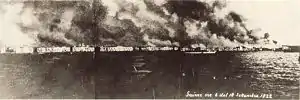
Returning to the street I found the stampede from the fire just beginning. All of the refugees that had been scattered through the streets or stowed in churches and other institutions were moving toward the waterfront. Steadily augmenting this flow were those abandoning their homes in the path of the fire...It was now dark. The quay was already filled with tens of thousands of terrified refugees moving aimlessly between the customs house and the point, and still the steady stream of new arrivals continued, until the entire waterfront seemed one solid mass of humanity and baggage of every description.[49]
The heat from the fire was so intense that Hepburn was worried that the refugees would die as a result of it.[49] The refugees' situation on the pier on the morning of 14 September was described by the British Lieutenant A. S. Merrill, who believed that the Turks had set the fire to keep the Greeks in a state of terror so as to facilitate their departure:[13]
All morning the glow and then the flames of burning Smyrna could be seen. We arrived about an hour before dawn and the scene was indescribable. The entire city was ablaze and the harbor was light as day. Thousands of homeless refugees were surging back and forth on the blistering quay – panic stricken to the point of insanity. The heartrending shrieks of women and children were painful to hear. In a frenzy they would throw themselves into the water and some would reach the ship. To attempt to land a boat would have been disastrous. Several boats tried and were immediately stopped by the mad rush of a howling mob...The crowds along the quay beyond the fire were so thick and tried so desperately to close abreast the men-of-war anchorage that the masses in the stifling center could not escape except by sea. Fortunately there was a sea breeze and the quay wall never got hot enough to roast these unfortunate people alive, but the heat must have been terrific to have been felt in the ship 200 yards away. To add to the confusion, the packs belonging to these refugees – consisting mostly of carpets and clothing – caught fire, creating a chain of bonfires the length of the street.[53]
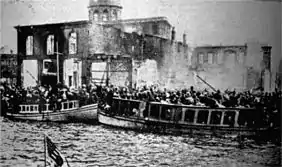
Turkish troops cordoned off the Quay to box the Armenians and Greeks within the fire zone and prevent them from fleeing.[54] Eyewitness reports describe panic-stricken refugees diving into the water to escape the flames and that their terrified screaming could be heard miles away.[42] By 15 September the fire had somewhat died down, but sporadic violence by the Turks against the Greek and Armenian refugees kept the pressure on the Western and Greek navies to remove the refugees as quickly as possible.[55] The fire was completely extinguished by 22 September,[13] and on 24 September the first Greek ships – part of a flotilla organized and commandeered by the American humanitarian Asa Jennings – entered the harbor to take passengers away, following Captain Hepburn's initiative and his having obtained permission and cooperation from the Turkish authorities and the British admiral in charge of the destroyers in the harbor.[53]
Aftermath
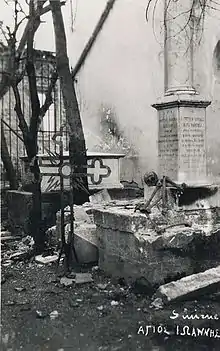
The evacuation was difficult despite the efforts of British and American sailors to maintain order, as tens of thousands of refugees pushed and shoved towards the shore.[53] Attempts to organize relief were made by the American officials from the YMCA and YWCA, who were reportedly robbed and later shot at by Turkish soldiers.[56] On the quay, Turkish soldiers and irregulars periodically robbed Greek refugees, beating some and arresting others who resisted.[53] Though there were several reports of well-behaved Turkish troops helping old women and trying to maintain order among the refugees,[53] these are heavily outnumbered by those describing gratuitous cruelty, incessant robbery and violence.[55]
American and British attempts to protect the Greeks from the Turks did little good, with the fire having taken a terrible toll.[55] Some frustrated and terrified Greeks took their own lives, plunging into the water with packs at their back, children were stampeded, and many of the elderly fainted and died.[55] The city's Armenians also suffered grievously, and according to Captain Hepburn, "every able-bodied Armenian man was hunted down and killed wherever found, with even boys aged 12 to 15 taking part in the hunt".[55]
The fire completely destroyed the Greek, Armenian, and Levantine quarters of the city, with only the Turkish and Jewish quarters surviving.[42] The thriving port of Smyrna, one of the most commercially active in the region, was burned to the ground. Some 150,000–200,000 Greek refugees were evacuated, while approximately 30,000 able-bodied Greek and Armenian men were deported to the interior, many of them dying under the harsh conditions or executed along the way.[13] The 3,000-year Greek presence on Anatolia's Aegean shore was brought to an abrupt end,[13] along with the Megali Idea.[57] The Greek writer Dimitris Pentzopoulos wrote, "It is no exaggeration to call the year '1922' the most calamitous in modern Hellenic history."[13]
Responsibility
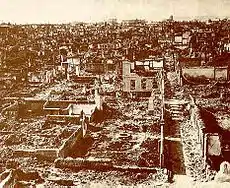
The question of who was responsible for starting the great fire of Smyrna continues to be debated, with Turkish sources mostly attributing responsibility to Greeks or Armenians and vice versa.[58][59]
A number of studies have been published on the Smyrna fire. Professor of literature Marjorie Housepian Dobkin's Smyrna 1922, a meticulously documented chronicle of the events according to the New York Times,[60] concludes that the Turkish Army systematically burned the city and killed Christian Greek and Armenian inhabitants. Her work is based on extensive eyewitness testimony from survivors, Allied troops sent to Smyrna during the evacuation, foreign diplomats, relief workers, and Turkish eyewitnesses. A study by historian Niall Ferguson comes to the same conclusion. Historian Richard Clogg categorically states that the fire was started by the Turks following their capture of the city.[42] In his book Paradise Lost: Smyrna 1922, Giles Milton addresses the issue of the Smyrna Fire through original material (interviews, unpublished letters, and diaries) from the Levantine families of Smyrna, who were mainly of British origin. All the documents collected by the author during this research are deposited in Exeter University Library.[61] The conclusion of the author is that it was Turkish soldiers and officers who set the fire, most probably acting under direct orders. British scholar Michael Llewellyn-Smith, writing on the Greek administration in Asia Minor, also concludes that the fire was "probably lit" by the Turks as indicated by what he calls "what evidence there is".[62]
American historian Norman Naimark has evaluated the evidence regarding the responsibility of the fire. He agrees with the view of American Lieutenant Merrill that it was in Turkish interests to terrorize Greeks into leaving Smyrna with the fire, and points out to the "odd" fact that the Turkish quarter was spared from the fire as a factor suggesting Turkish responsibility. However, he points out that there is no "solid and substantial evidence" of this and that it can be argued that burning the city was against Turkish interests and was unnecessary. He also suggests that the responsibility may lie with Greeks and Armenians as they "had own their good reasons", pointing out to the "Greek history of retreating" and "Armenian attack in the first day of the occupation". But normally this considered as an escapism or an excuse for their failure to help the Christians and shift to shift the responsibility to the victims[4]
Horton and Housepian are criticized by Heath Lowry and Justin McCarthy, who argue that Horton was highly prejudiced and Housepian makes an extremely selective use of sources.[63] Lowry and McCarthy are members of the Institute of Turkish Studies and have in turn been strongly criticized by other scholars for their denial of the Armenian Genocide[64][65][66][67] and McCarthy has been described by Michael Mann as being on "the Turkish side of the debate."[68] Horton, however, has been criticised as anti-Turkish by a number of other scholars. Professor Biray Kolluoğlu Kırlı has accused Horton of having a "crudely explicit" anti-Turkish bias,[69] while in his review of Horton's work, Professor Emeritus Peter M. Buzanski has attributed Horton's anti-Turkish stance to his well-known "fanatic" philhellenism and his wife being Greek, and written "During the Turkish capture of Smyrna, at the end of the Greco-Turkish War, Horton suffered a breakdown, resigned from the diplomatic service, and spent the balance of his life writing anti-Turkish, pro-Greek books."[70] Brian Coleman, reviewing Horton's work, has characterised it as "a demonization of Muslims, in general, and of Turks, in particular" and stated that Horton wrote not as historian, but as publicist.[71]
Turkish author and journalist Falih Rifki Atay, who was in Smyrna at the time, and the Turkish professor Biray Kolluoğlu Kırlı agreed that the Turkish Army was responsible for the destruction of Smyrna in 1922. More recently, a number of non-contemporary scholars, historians, and politicians have added to the history of the events by revisiting contemporary communications and histories. Leyla Neyzi, in her work on the oral history regarding the fire, makes a distinction between Turkish nationalist discourse and local narratives. In the local narratives, she points out to the Turkish forces being held responsible for at least not attempting to extinguish the fire effectively, or, at times, being held responsible for the fire itself.[72]
Other accounts contradict some of the facts presented in the above works. These include a telegram sent by Mustafa Kemal, articles in contemporary newspapers, and a short non-contemporary essay by Turkish historian Reşat Kasaba of the University of Washington, who briefly describes events without making clear accusations.[73]
The accounts of Jewish teachers in Smyrna, letters of Johannes Kolmodin (a Swedish Orientalist who was in Smyrna at the time), and Paul Grescovich say that Greeks or Armenians were responsible for the fire. R.A. Weight stated that "his clients showed that the fire, in its origin, was a small accidental fire, though it eventually destroyed a large section of the town".[74]
Casualties and refugees
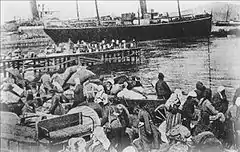
The number of casualties from the fire is not precisely known, with estimates of up to 100,000[5][7] Greeks and Armenians killed. American historian Norman Naimark gives a figure of 10,000–15,000 dead,[13] while historian Richard Clogg gives a figure of 30,000.[42] Larger estimates include that of John Freely at 50,000 and Rudolf Rummel at 100,000.[7]
Help to the city's population by ships of the Hellenic Navy was limited, as the 11 September 1922 Revolution had broken out, and the most of the Greek army was concentrated at the islands of Chios and Lesbos, planning to overthrow the royalist government of Athens.
Although there were numerous ships from various Allied powers in the harbor of Smyrna, the vast majority of them cited "neutrality" and did not pick up Greeks and Armenians who were forced to flee from the fire and the Turkish troops retaking the city after the Greek Army defeat.[75] Military bands played loud music to drown out the screams of those who were drowning in the harbor and who were forcefully prevented from boarding Allied ships.[76] A Japanese freighter dumped all of its cargo and took on as many refugees as possible, taking them to the Greek port of Piraeus.[77][78]
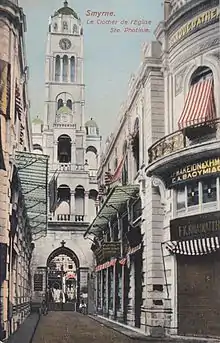
Many refugees were rescued via an impromptu relief flotilla organized by American missionary Asa Jennings.[80] Other scholars give a different account of the events; they argue that the Turks first forbade foreign ships in the harbor to pick up the survivors, but, under pressure especially from Britain, France, and the United States, they allowed the rescue of all the Christians except males 17 to 45 years old. They intended to deport the latter into the interior, which "was regarded as a short life sentence to slavery under brutal masters, ended by mysterious death".[81]
The number of refugees changes according to the source. Some contemporary newspapers claim that there were 400,000 Greek and Armenian refugees from Smyrna and the surrounding area who received Red Cross aid immediately after the destruction of the city.[9] Stewart Matthew states that there were 250,000 refugees who were all non-Turks.[15] Naimark gives a figure of 150,000–200,000 Greek refugees evacuated.[13] Edward Hale Bierstadt and Helen Davidson Creighton say that there were at least 50,000 Greek and Armenian refugees.[8] Some contemporary accounts also suggest the same number.[82]
The number of Greek and Armenian men deported to the interior of Anatolia and the number of consequent deaths varies across sources. Naimark writes that 30,000 Greek and Armenian men were deported there, where most of them died under brutal conditions.[13] Dimitrije Đorđević puts the number of deportees at 25,000 and the number of deaths at labour battalions at 10,000.[14] David Abulafia states that at least 100,000 Greeks were forcibly sent to the interior of Anatolia, where most of them died.[12]
Aristotle Onassis, who was born in Smyrna and who later became one of the richest men in the world, was one of the Greek survivors. The various biographies of his life document aspects of his experiences during the Smyrna catastrophe. His life experiences were featured in the TV movie called Onassis, The Richest Man in the World.[83]
During the Smyrna catastrophe, the Onassis family lost substantial property holdings, which were either taken or given to Turks as bribes to secure their safety and freedom. They became refugees, fleeing to Greece after the fire. However, Aristotle Onassis stayed behind to save his father, who had been placed in a Turkish concentration camp. He was successful in saving his father's life. During this period three of his uncles died. He also lost an aunt, her husband Chrysostomos Konialidis, and their daughter, who were burned to death when Turkish soldiers set fire to a church in Thyatira, where 500 Christians had found shelter to avoid Turkish soldiers and the great fire of Smyrna.[83]
Aftermath
The entire city suffered substantial damage to its infrastructure. The core of the city literally had to be rebuilt from the ashes. Today, 40 hectares of the former fire area is a vast park named Kültürpark serving as Turkey's largest open air exhibition center, including the İzmir International Fair, among others.
According to the first census in Turkey after the war, the total population of the city in 1927 was 184,254, of whom 162,144 (88%) were Muslims, the remainder numbering 22,110.[84]
In art, music, and literature
- Robert Byron's travelogue Europe in the Looking Glass (1926) contains an eyewitness report, placing the blame for the fire upon the Turks.[85]
- "On the Quai at Smyrna" (1930), a short story published as part of In Our Time, by Ernest Hemingway, alludes to the fire of Smyrna:
The strange thing was, he said, how they screamed every night at midnight ... We were in the harbour and they were on the pier and at midnight they started screaming. We used to turn the searchlight on them to quiet them. That always did the trick.[86]
- Eric Ambler's novel The Mask of Dimitrios (1939) details the events at Smyrna at the opening of chapter 3.[87]
- The closing section of Edward Whittemore's Sinai Tapestry (1977) takes place during the great fire of Smyrna.[88]
- Part of the novel The Titan (1985) by Fred Mustard Stewart takes place during the great fire of Smyrna.[89]
- Susanna de Vries Blue Ribbons Bitter Bread (2000)[90] is an account of Smyrna and the Greek refugees who landed at Thessaloniki.
- The novel Middlesex ((2002) by American Jeffrey Eugenides opens with the great fire of Smyrna.[91]
- Mehmet Coral's İzmir: 13 Eylül 1922 ("Izmir: 13 September 1922") (2003?)[92] addressed this topic;[93] it was also published in the Greek language by Kedros of Athens/Greece under the title: Πολλές ζωές στη Σμύρνη (Many lives in Izmir).[94]
- Greek-American singer-songwriter Diamanda Galas's album Defixiones: Will and Testament (2003) is directly inspired by the Turkish atrocities committed against the Greek population at Smyrna. Galas is descended from a family who originated from Smyrna.[95]
- Part of the novel Birds Without Wings (2004) by Louis De Bernieres takes place during the great fire of Smyrna and its aftermath.[96]
- Panos Karnezis's 2004 novel The Maze deals with historical events involving and related to the fire at Smyrna.[97]
- "Smyrna: The Destruction of a Cosmopolitan City – 1900–1922", a 2012 documentary film by Maria Ilioú,[98]
- Deli Sarkis Sarkisian's personal account of the fire of Smyrna is related in Ellen Sarkisian Chesnut's The Scars He Carried, A Daughter Confronts The Armenian Genocide and Tells Her Father's Story (2014).[99]
See also
Notes
- Stewart, Matthew. "Catastrophe at Smyrna." History Today, Volume: 54 Issue 7.
- Tsounis, Catherine (8 September 2010). "Remembering Smyrna: The Asia Minor Catastrophe". Queens Gazette. Archived from the original on 15 July 2011. Retrieved 13 May 2011.
- Horton, George. The Blight of Asia. Indianapolis: The Bobbs-Merrill Company, 1926; repr. London: Gomidas Institute, 2003, p. 96.
- Naimark, Norman M. (2002). Fires of Hatred. Harvard University Press. pp. 47–52. ISBN 978-0-674-00994-3.
- Biondich, Mark (2011). The Balkans: Revolution, War, and Political Violence Since 1878. Oxford University Press. p. 92. ISBN 9780199299058.
- Naimark, Norman M. Fires of Hatred: Ethnic Cleansing in Twentieth-Century Europe. Cambridge: MA: Harvard University Press, 2002, p. 52.
- Irving Louis Horowitz; Rudolph J. Rummel (1994). "Turkey's Genocidal Purges". Death by Government. Transaction Publishers. ISBN 978-1-56000-927-6., p. 233.
- Edward Hale Bierstadt, Helen Davidson Creighton. The Great betrayal: A Survey of the Near East Problem (1924), R. M. McBride & company, p. 218
- "U.S. Red Cross Feeding 400,000 Refugees," Japan Times and Mail, 10 November 1922.
- Trudy Ring; Noelle Watson; Paul Schellinger (2013). Southern Europe: International Dictionary of Historic Places. Routledge. p. 351. ISBN 9781134259588. Retrieved 23 February 2014.
Kemal's triumphant entry into Smyrna... as Greek and Armenian inhabitants were raped, mutilated, and murdered.
- Abulafia, David (2011). The Great Sea : A Human History of the Mediterranean. New York: Oxford University Press. p. 287. ISBN 9780195323344. Retrieved 23 February 2014.
As the refugees crowded into the city, massacres, rape and looting, mainly but not exclusively by the irregulars, became the unspoken order of the day... Finally, the streets and houses of Smyrna were soaked in petrol... and on 13 September the city was set alight.
- Abulafia, David (2011). The Great Sea : A Human History of the Mediterranean. New York: Oxford University Press. p. 588. ISBN 9780195323344.
... and at least as many were deported into the Anatolian interior, where most vanished.
- Naimark 2002, p. 52
- Djordjevic, Dimitrije (1989). Ninic, Ivan (ed.). Migrations in Balkan History. Serbian Academy of Sciences and Arts, Institute for Balkan Studies. p. 121. ISBN 9788671790062.
- Stewart, Matthew (1 January 2003). "It Was All a Pleasant Business: The Historical Context of 'On the Quai at Smyrna'". The Hemingway Review. 23 (1): 58–71. doi:10.1353/hem.2004.0014. S2CID 153449331.
- "Snuffed Out in a Single Week". The Sunday Times. UK. 15 June 2008. Archived from the original on 15 June 2011.CS1 maint: bot: original URL status unknown (link), via the Internet Archive
- Lowry, "Turkish History."
- list of them here
- i.e. The Daily Telegraph 19 September 1922: The martyrdom of Smyrna and eastern Christendom; a file of overwhelming evidence, denouncing the misdeeds of the Turks in Asia Minor and showing their responsibility for the horrors of Smyrna Incendiaries at work – Destruction of christian quarters]
- Daily Mail:
- Slim, Hugo (2010). Killing civilians : method, madness, and morality in war. New York: Columbia University Press. p. 129. ISBN 9780231700375.
- Fleming Katherine Elizabeth. Greece: A Jewish History. Princeton: Princeton University Press, 2008, p. 81. ISBN 978-0-691-10272-6.
- Ring Trudy, Salkin Robert M., La Boda Sharon. International Dictionary of Historic Places: Southern Europe. Taylor & Francis, 1995. ISBN 978-1-884964-02-2, p. 351
- Salâhi R. Sonyel, Minorities and the Destruction of the Ottoman Empire, Ankara: TTK, 1993, p. 351; Gaston Gaillard, The Turks and Europe, London, 1921, p. 199.
- Morgenthau Henry. Ambassador Morgenthau's Story Garden City, NY: Doubleday, Page & Company, 1918, p. 32.
- Horton, The Blight of Asia
- "The Whispering Voices of Smyrna: The Destruction and Genocide of a Christian City | Institute on the Holocaust & Genocide in Jerusalem". www.ihgjlm.com. Retrieved 21 June 2018.
- Panayi, Panikos (1998). Outsiders History of European Minorities. London: Continuum International Pub. Group. p. 111. ISBN 9780826436313.
- MacMillan, Margaret (2003). Paris 1919 six months that changed the world (Random House trade paperback ed.). New York: Random House. p. 430. ISBN 9780307432964.
- Clogg, Richard (20 June 2002). A Concise History of Greece. Cambridge University Press. pp. 94. ISBN 9780521004794.
Refugees crowded on the waterfront at Smyrna on 13 September 1922 after fire had devastated much of the Greek, Armenian and Prankish [European] quarters of the city which the Turks had called Gavur Izmir or 'Infidel Izmir', so large was its non-Muslim population.
- Hans-Lukas Kieser (26 December 2006). Turkey Beyond Nationalism: Towards Post-Nationalist Identities. I.B.Tauris. pp. 49–. ISBN 978-1-84511-141-0.
They called Izmir "Gavur Izmir" (infidel Izmir) because the majority of its population consisted of non- Muslims and Levantines. They could not forget the fact that while a National War of Independence was going on, the minorities living in ...
- Mindie Lazarus-Black; Susan F. Hirsch (12 November 2012). Contested States: Law, Hegemony and Resistance. Routledge. pp. 273–. ISBN 978-1-136-04102-0.
Not surprisingly, Smyrna was the most cosmopolitan city in the Levant in the eighteenth century. It was called gavur Izmir (infidel Izmir) because of the prominence of the Christians.
- Vivre avec l'ennemi: La cohabitation de communautés hétérogènes du XVIe au XIXe siècle. Presses Univ Blaise Pascal. 2008. pp. 6–. ISBN 978-2-84516-380-5.
Située sur la côte anatolienne, Smyrne (ou Izmir en turc) est aux XVIIIe ... (c'est-à-dire chrétienne et juive) est majoritaire au XIXe siècle, à tel point que ses habitants musulmans la surnomment " gavur Izmir ", Smyrne l'Infidèle.
- Muḥammad Ḥusayn Ḥusaynī Farāhānī (1990). A Shi'ite Pilgrimage to Mecca: 1885–1886. Saqi Books. p. 150. ISBN 978-0-86356-356-0.
Its bazaars are mostly covered and have red-tiled roofs. Most of the people of this city are Europeans, Greeks, or Jews. Because the Turks call those outside the religion of Islam "gavur," [the city] is popularly known as "Gavur Izmir."
- C. M. Hann (1994). When History Accelerates: Essays on Rapid Social Change, Complexity, and Creativity. Athlone Press. p. 219. ISBN 978-0-485-11464-5.
Izmir was the most cosmopolitan city in the Levant in the eighteenth century and was called gavur Izmir (infidel Izmir) because of the prominence of the non-Muslims.
- M. Th. Houtsma (1993). E. J. Brill's First Encyclopaedia of Islam, 1913–1936. BRILL. pp. 569–. ISBN 978-90-04-09790-2.
- Clogg, Richard (1992). A Concise History of Greece. Cambridge: Cambridge University Press. pp. 97, 257.
- Dobkin, Marjorie Housepian. Smyrna 1922: The Destruction of a City. New York: Harcourt Brace Jovanovich, 1971; 2nd ed. Kent, Ohio: Kent State University Press, 1988, pp. 117–121.
- Dobkin. Smyrna 1922, p. 101.
- Milton 2008, pp. 4–5.
- See Dobkin, Smyrna 1922, passim.
- Clogg 1992, p. 98.
- Dobkin. Smyrna 1922, pp. 120–167.
- Dobkin. Smyrna 1922, pp. 133–134.
- Schaller Dominik J., Zimmerer Jürgen (13 September 2013). Late Ottoman Genocides – Schaller: The Dissolution of the Ottoman Empire and Young Turkish Population and Extermination Policies. Routledge. p. 46. ISBN 9781317990451. Retrieved 8 June 2014.
Member of the De Jongh family, merchant Oscar de Jongh and his wife were killed by Turkish cavaly on September 9, 1922
- Murat, John (1997). The infamy of a great betrayal ([Repr.]. ed.). Internat. Press. p. 139. ISBN 9780960035670. Retrieved 8 June 2014.
- Papoutsy, Christos (2008). Ships of mercy : the true story of the rescue of the Greeks : Smyrna, September 1922. Portsmouth, N.H.: Peter E. Randall. p. 36. ISBN 9781931807661. Retrieved 8 June 2014.
Doctor Murphy, a retired British army surgeon, was attacked in his home at Bournabat... but Murphy was beaten to death while trying to prevent the rape of a servant girl
- Naimark. Fires of Hatred, p. 249.
- Naimark 2002, p. 49
- Milton 2008, p. 306.
- Milton 2008, pp. 306–307.
- Dobkin. Smyrna 1922, pp. 156–157.
- Naimark 2002, p. 50
- Dobkin. Smyrna 1922, p. 231.
- Naimark 2002, p. 51
- "SMYRNA'S RAVAGERS FIRED ON AMERICANS" (PDF). New York Times. 18 September 1922. Retrieved 28 July 2010.
- Clogg 1992, p. 99
- Neyzi, Leyla (2008). "The Burning of Smyrna/ Izmir (1922) Revisited: Coming to Terms with the Past in the Present". The Past as Resource in the Turkic Speaking World: 23–42. doi:10.5771/9783956506888-23. ISBN 9783956506888.
- Martoyan, Tehmine (2017). "The Destruction of Smyrna in 1922: An Armenian and Greek Shared Tragedy". In Shirinian, George N. (ed.). Genocide in the Ottoman Empire: Armenians, Assyrians, and Greeks, 1913-1923. Berghahn Books. ISBN 978-1-78533-433-7.
- "Smyrna 1922: The Destruction of a City—A Review of Marjorie Housepian Dobkin's Work by Chris and Mary Papoutsy". www.helleniccomserve.com. Retrieved 21 June 2018.
- Milton 2008, p. xx..
- Llewellyn Smith, Michael (1998). Ionian Vision: Greece in Asia Minor, 1919–1922. C. Hurst & Co. p. 308. ISBN 1850653682.
- Lowry, Heath. "Turkish History: On Whose Sources Will it Be Based? A Case Study on the Burning of Izmir," The Journal of Ottoman Studies, IX, 1988; Justin McCarthy, Death and Exile. The Ethnic Cleansing of Ottoman Muslims. Princeton: Darwin Press, 1995, pp. 291–292, 316–317 and 327.
- Auron, Yair. The Banality of Denial: Israel and the Armenian Genocide. New Brunswick, N.J.: Transaction Publishers, 2003, p. 248.
- Charny, Israel W. Encyclopedia of Genocide, Vol. 2. Santa Barbara, CA: ABC-CLIO, 1999, p. 163.
- Dadrian, Vahakn N. "Ottoman Archives and the Armenian Genocide" in The Armenian Genocide: History, Politics, Ethics. Richard G. Hovannisian (ed.) New York: Palgrave MacMillan, 1992, p. 284.
- Hovannisian, Richard G. "Denial of the Armenian Genocide in Comparison with Holocaust Denial" in Remembrance and Denial: The Case of the Armenian Genocide. Richard G. Hovannisian (ed.) Detroit: Wayne State University Press, 1999, p. 210.
- Michael Mann, The Dark Side of Democracy: explaining ethnic cleansing, pp. 112–114, Cambridge, 2005 "... figures are derive[d] from McCarthy (1995: I 91, 162–164, 339), who is often viewed as a scholar on the Turkish side of the debate."
- Kırlı, Biray Kolluoğlu (2005). "Forgetting the Smyrna Fire" (PDF). History Workshop Journal. Oxford University Press. 60 (60): 25–44. doi:10.1093/hwj/dbi005. S2CID 131159279. Retrieved 10 March 2016.
- Buzanski, Peter Michael (1960). Admiral Mark L. Bristol and Turkish-American Relations, 1919–1922. University of California, Berkeley. p. 176.
- Coleman, Brian, "George Horton: the literary diplomat", Byzantine and Modern Greek Studies, Volume 30, Number 1, January 2006, pp. 81–93(13). DOI:10.1179/030701306X96618 (subscription required)
- Neyzi, Leyla (2008). "Remembering Smyrna/Izmir" (PDF). History & Memory. 20 (2). doi:10.2979/his.2008.20.2.106. S2CID 159560899. Retrieved 4 July 2016.
- Reşat Kasaba"İzmir 1922: A port city unravels" Archived 3 March 2016 at the Wayback Machine, Arts, York University.
- The Post Magazine and Insurance Monitor, Volume 85, Issue 2 (1924), Buckley Press, p. 2153
- Dr. Esther Lovejoy, "Woman Pictures Smyrna Horrors," New York Times, 9 October 1922.
- Dobkin. Smyrna 1922, p. 71.
- "Japanese at Smyrna", Boston Globe, 3 December 1922.
- Stavridis, Stavros. "The Japanese Hero," The National Herald. 19 February 2010.
- "Aya Fotini". levantineheritage.com. Retrieved 24 May 2017.
- Archived 27 May 2009 at the Wayback Machine
- Rummel-Horowitz, p. 233.
- Moderator-topics, Volume 43 (1922), p. 60
- Onassis, The Richest Man in the World (1988), movie for television, directed by Waris Hussein.
- Modernity and Culture: From the Mediterranean to the Indian Ocean, Leila T. Fawaz, Christopher Alan Bayly, Robert Ilbert, page 207
- Byron, Robert (2012). Europe in the Looking Glass. p. 180. ISBN 9781843913573.
- Hemingway, Ernest (2 July 1961). The complete short stories of Ernest Hemingway. p. 63. ISBN 978-0-684-84332-2. Retrieved 28 July 2010.
- Ambler, Eric (28 May 2009). "Chapter 3". The Mask of Dimitrios. Penguin UK. ISBN 9780141924540.
- Steinberg, Theodore Louis (2005). Twentieth-century Epic Novels. University of Delaware Press. pp. 175–176. ISBN 9780874138894.
- Mustard Stewart, Fred (1985). The Titan. p. 180. ISBN 9780671506896.
- Vries, Susanna De (9 October 2017). Blue Ribbons, Bitter Bread: The Life of Joice NanKivell Loch. Pandanus Press. ISBN 9780958540858 – via Google Books. Pirgos Press/Dennis Jones Melbourne 2012, 2014, (6 editions).
- Wheelwright, Julie (19 October 2002). "Middlesex, by Jeffrey Eugenides". The Independent.
- presumably same as "The Ashes of Smyrna" listed on author's page
- Bellér-Hann, Ildikó (2008). The Past as Resource in the Turkic Speaking World. Ergon. p. 27. ISBN 9783899136166.
- "ΠΟΛΛΕΣ ΖΩΕΣ ΣΤΗ ΣΜΥΡΝΗ" [MANY LIVES IN SMYRNA] (in Greek). Βιβλιοπωλείο Πολιτεία.
- Solotroff, Mark (23 February 2012). "Artist on Artist: Diamanda Galas talks to Mark Solotroff". Chicago Reader Book Club.
- Barclay, Jennifer (2020). Wild Abandon: A Journey to the Deserted Places of the Dodecanese. Bradt Guides. p. 137. ISBN 9781784777906.
- Georganta, Konstantina (1 May 2013). "Home and Displacement: The Dynamic Dialectics of 1922 Smyrna". Synthesis: An Anglophone Journal of Comparative Literary Studies (5): 138. doi:10.12681/syn.17435.
- "Smyrna: The Destruction of a Cosmopolitan City – 1900–1922". www.imdb.com. 2012. uses contemporaneous film footage and photographs, and the testimony of surviving witnesses, to tell the story of the city and its destruction.
- "Ellen Sarkisian Chesnut – Deli Sarkis: The Scars He Carried". www.scarshecarried.com.
Bibliography
- Horton, George, The Blight of Asia, An Account of the Systematic Extermination of Christian Populations by Mohammedans and of the Culpability of Certain Great Powers; with the True Story of the Burning of Smyrna. Indianapolis: The Bobbs-Merrill Company, 1926; repr. Gomidas Institute, London, 2003 ISBN 978-1-903656-15-0.
- Milton, Giles (2008). Paradise Lost: Smyrna 1922: The Destruction of Islam's City of Tolerance (Paperback ed.). London: Sceptre; Hodder & Stoughton Ltd. ISBN 978-0-340-96234-3. Retrieved 28 July 2010.
- Heath Lowry, "Turkish History: On Whose Sources Will it Be Based? A Case Study on the Burning of Izmir," The Journal of Ottoman Studies, IX, 1988.
Further reading
- Karagianis, Lydia, Smoldering Smyrna, Carlton Press, June 1996; ISBN 978-0-806-25114-1.
- Papoutsky, Christos, Ships of Mercy: The True Story of the Rescue of the Greeks, Smyrna, September 1922, Peter E. Randall (2008) ISBN 978-1-931807-66-1
- Mansel, Philip. Levant: Splendour and Catastrophe on the Mediterranean, London, John Murray, 2010, hardback, 480 pages, ISBN 978-0-7195-6707-0, New Haven, Yale University Press, 2011, hardback, 470 pages, ISBN 978-0-300-17264-5
- Der-Sarkissian, Jack. "Two Armenian Physicians in Smyrna: Case Studies in Survival." Armenian Smyrna/Izmir: The Aegean Communities, Ed. Richard G. Hovannisian. Costa Mesa, California: Mazda Publishers, August 1, 2012. ISBN 978-1568591582
- Ureneck, Lou. The Great Fire: One American's Mission to Rescue Victims of the 20th Century's First Genocide, Ecco Press, 2015
External links
| Wikimedia Commons has media related to Great Fire of Smyrna. |
- Association of Smyrneans
- Remembering Smyrna/Izmir: Shared History, Shared Trauma, Levantine Heritage
- Smyrna 1922, a rare film, on Vimeo – shows before and after the fire